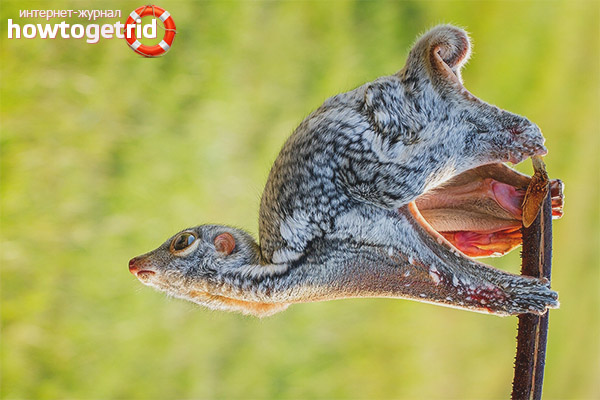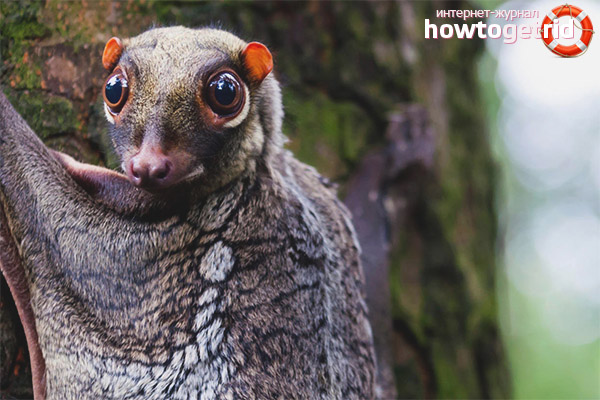The content of the article
Our planet is inhabited by many amazing creatures that few have heard of. One of these creatures is the winged wing, or as it is also called - kaguan. This is a woody mammal that is found in some countries of Southeast Asia and has only 2 species: Malay and Filipino.
The winged wing owes its name to a wide membrane covered with wool, connecting its limbs and tail. This design resembles wings and allows the animal to plan for distances of up to 140 meters (while the height loss is only 10-12 meters) - this is one and a half times farther than many other planning animals, such as flying squirrels, can afford. For a day, this small animal is able to fly around an area of up to one and a half kilometers.
Appearance
The appearance of a winged wing resembles a cross between a lemur and a bat. It does not apply to any of them. However, the opinions of naturalists on this matter diverge greatly: some classify woolly wings as semi-monkeys, others see them as carnivores or the aforementioned bats. But most scientists still distinguish the winged wings in a separate detachment, which eventually became their name. In common people they are also called flying cats or winged monkeys.
Continuing the theme of appearance, it is worth noting that the winged wing is a small animal, the dimensions and weight of which do not exceed the same parameters as an ordinary domestic cat. Large bulging eyes and small rounded ears on an elongated muzzle give these animals a pretty appearance.
The color of woolly wool is extremely different in the range from gray to brown. Light spots may protrude from the sides, and the abdomen, as a rule, has a light brown hue. Usually the color depends on the sex of the animal. For example, most gray individuals are females.
A distinctive feature of the kaguan among other animals is its teeth, or rather the upper fangs and incisors, which have two roots. Incisors of the lower row on the inside of the jaw resemble a comb with frequent teeth (20 grooves on each incisor). This feature, apparently, is necessary for extracting pulp from food.
Lifestyle
Without exaggeration, the winged wings can be called introverts in the animal world - they prefer to live alone, although they do not feel great discomfort in a small company of other individuals and are even able to communicate with each other using piercing screams that resemble the crying of a baby. Friendly relations between kaguans occur mainly between the opposite sex and young animals. However, two sexually mature males in a collision can be aggressive towards each other.
Woolwing - nocturnal animals. Their binocular vision perfectly allows them to see and navigate in the dark. In the afternoon, the winged wings prefer to rest, hanging from tree branches like sloths, curling up in a ball or climbing into a hollow (even at a distance of half a meter from the ground).
The diet of woolly wings consists mainly of fresh foliage. Also, these animals do not disdain to eat fruit, vegetable buds and flowers.And they quench their thirst with the help of moisture contained in the same foliage or on its surface after rain, or the formation of morning dew.
Breeding

Wormwing is not marsupial animals, however, it is similar to them in the characteristics of breeding. The mating season of kaguan is not tied to a specific time period. The female brings posterity once a year. For two months, she carries one cub (less often two) in the womb, and then gives birth to him in the light: blind, naked and defenseless. Within six months after birth, the baby will cling to the abdomen of the mother and travel with her along the branches and between the trees in search of food and a safe place. At the same time, the female twists her tail so that it forms a fold, similar to a bag or pocket, which protects the cub from accidental fall and injury.
To become an adult independent individual in a newborn wool-wing will turn out after 2, or even 3 years. Whether it is a lot or a little, it’s hard to say for sure, because the average life expectancy of woolly-winged animals remains a mystery to this day. However, the largest age that was recorded in the winged wing is 17.5 years. This individual was kept out of will, and then escaped, leaving open the question of its longevity.
Habitat
Species extinction
Woolwing is threatened with extinction and is listed in the Red Book of the International Union for Conservation of Nature. Someone exterminates them as pests of plant crops, and someone for the sake of tasty meat and valuable fur. Deforestation also does not bode well for the winged wings, depriving them of their habitats.
In addition to the human factor, the Filipino harpy or, as it is also called, the monkey eater, poses a serious danger to the kaguan. This is a large strong bird of the hawk detachment, whose diet consists almost entirely of defenseless woolly wings. Although it remains unclear how a daytime predator hunts down animals that prefer a nocturnal lifestyle.
Video: Wingedwing (Dermoptera)










Submit